“Birthright, Part I”
Written by Brannon Braga
Directed by Winrich Kolbe
Season 6, Episode 15
Production episode 40276-242
Original air date: February 22, 1993
Stardate: 46578.4
Captain’s Log: The Enterprise has docked at Station Deep Space 9 to assist in the rebuilding of an aqueduct on Bajor. While Picard and Crusher head to ops, Worf and La Forge have lunch at the replimat: pasta al fiorello, one of La Forge’s favorites. However, while La Forge pushes his plate away, threatening to talk to O’Brien about the replicators and saying it tastes like liquid polymer, Worf loves it and continues to chow down as La Forge looks for more edible pastures. A Yridian named Jaglom Shrek approaches Worf once he’s alone, identifying him as the son of Mogh. Shrek claims that Mogh did not die at Khitomer, but is still alive, along with several other Klingons who were captured and brought to a prison camp. Worf refuses to believe this—a Klingon would rather die than be taken prisoner—and storms off.
On the Enterprise, Data detects a power drain that originates from sickbay. He investigates to find Dr. Julian Bashir, DS9’s chief medical officer, fiddling with a medical scanner (at least, Bashir thinks that’s what it might be) that was found in the Gamma Quadrant. Bashir geeks out over getting to meet Data, who suggests examining the device in engineering.
Worf is a bit cranky and out of sorts—he rips Ensign Lopez’s head off for a poorly prepared duty roster, and then snaps at Riker before leaving the bridge. He tries to lose himself in mok’bara moves, and instead smashes his table. Troi chooses that moment to enter and pretty much forces Worf to tell her what Shrek told him. He refuses to believe that Mogh would allow himself to be so dishonored; Troi points out that refusing to acknowledge something because it’s uncomfortable is stupid.
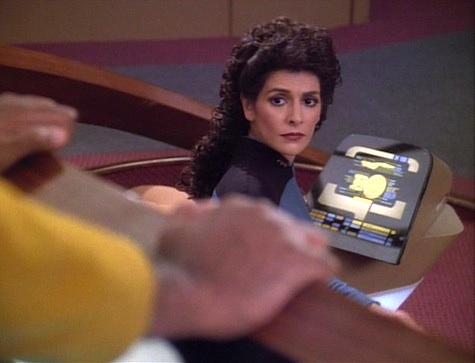
In engineering, Data, La Forge, and Bashir play with their new toy. Bashir continues to geek out: asking Data about his hair growth, that he breathes, that he mimics a pulse. The doctor is fascinated by the lengths his creator went to make Data appear human.
They turn on the device, and a power surge hits Data, who collapses to the deck—and then finds himself wandering the empty corridors of the Enterprise. Following a noise, he finds a man working an anvil—that man turns around and reveals himself to be a very young Noonian Soong.
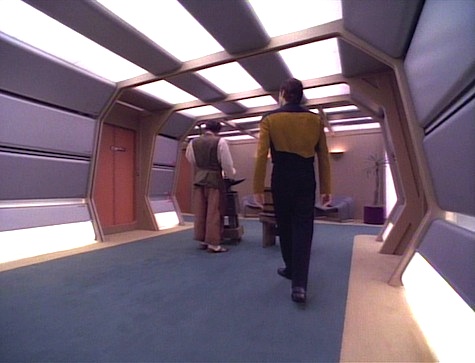
Suddenly, Data wakes up on the deck floor. La Forge said he was out of commission for forty-seven seconds—but Data has memories of events during those seconds of when he saw Soong, whom he identifies to Bashir as his father. His positronic brain logs that he was not active during that time. Bashir posits that he might have been dreaming or hallucinating. Data rejects the notion, as he’s a machine and can’t do that—but Bashir points out that most machines can’t grow hair.
Data approaches Worf in Ten-Forward. Worf had a vision when he was a child—his human parents took him to a lava cave where one meditates in extreme heat, which puts one in a hallucinatory state. For this reason, Data goes to Worf for advice about his own vision, which he describes. Worf describes it as a powerful vision, due to its involving his father. He advises Data to determine the vision’s meaning—and while doing so talks himself into accepting Shrek’s word.
Worf goes to DS9 and finds Shrek, and—using the dangle-the-guy-over-the-Promenade-railing method of negotiation—arranges for Shrek to take him to the camp, which is in the Carraya system on the edge of Romulan space, and that Worf will pay Shrek only after the trip is completed.
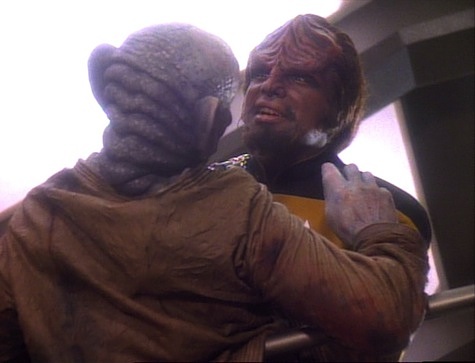
Data’s next stop on his advice tour is Picard. Data has been researching other cultures’ visions, and Picard advises him to view it from his own culture—yes, it’s a culture of one, but that makes it no less valid. He encourages Data to let the vision inspire him. So Data tries painting the images he saw.
Shrek lands on Carraya and gives Worf a homing beacon so he can find the ship when he returns in two days. They landed thirty kilometers away from the camp to avoid detection, and Worf goes the rest of the way on foot through dense, predator-filled jungle. Because he’s just that awesome.
He sees a woman bathing, and stares at her long enough for her to notice that he’s there—though she assumes it’s someone named Toq. Worf is confused by her ability to leave the camp so cavalierly, and the woman—named Ba’el—is confused by Worf’s talk of rescue and going home, as this is her home. Worf urges her not to tell anyone she saw him, to which she nervously agrees, and then she speaks to a Romulan guard. Worf is, to say the least, befuddled, as the woman is very young (Khitomer was two and a half decades ago) and isn’t acting like a prisoner.
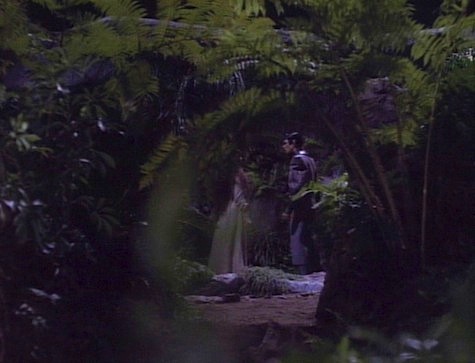
La Forge checks on Data, who has uncharacteristically missed a meeting, and finds that Data has made two dozen paintings based on his vision, and is currently painting two things at once (which is delightful). At one point he was inspired to paint an image of smoke, which he didn’t see—but it does look like the steam coming out of a water bucket used by a blacksmith. That led to several avian images, including a wing, a bird, and a flock of birds, none of which were in the vision, either. It’s increasingly clear to him that the vision wasn’t finished and he wishes to re-create what happened. La Forge is iffy, but agrees.
Bashir and La Forge do the same thing they did before, the plasma shock hits Data, and then he’s back in the corridor, again walking toward the blacksmith who looks like a young Soong. This time he sees what Soong is working on: a bird’s wing. He places it in the water bucket, which raises steam, and when the steam clears, there’s a raven, which flies off. He says the vision is different, at which point he’s on the bridge (sort of) with Soong again. Soong explains that his cognitive functions have proceeded far enough to allow him to dream, something Soong wasn’t sure would ever happen. Soong also says that Data himself is the bird, at which point we get a POV shot of him flying through the Enterprise corridors and out into space.
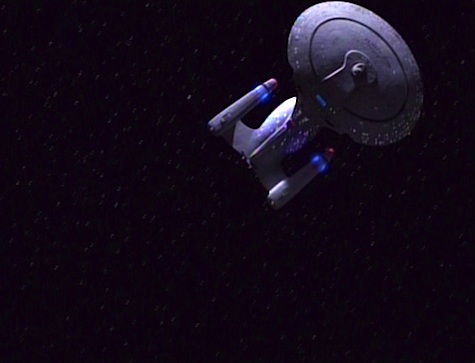
And then he wakes up.
Later Data explains to Bashir that the dream program was activated prematurely by the plasma shock. However, Data intends to deactivate himself once a night to see where the dreams take him. Bashir asks if he can write a paper on this, and Data agrees.
On Carraya, Worf breaks into the prison camp. He hears a Klingon voice singing, and avoids Romulan guards. He finds several Klingons, of varying ages, sitting around a fire, listening to one of the older ones sing a song. After the gathering disperses, Worf grabs the one who was singing—L’Kor, who tells Worf that Mogh died in battle at Khitomer. Worf is all ready to free them, but L’Kor says it’s a bit more complicated. “We are not leaving here,” L’Kor says, as two Romulan guards show up with disruptors out, “and neither are you.”
To be continued….
Can’t We Just Reverse the Polarity?: Bashir is never able to figure out what his medical scanner’s supposed to do, but it does provoke a plasma shock in Data that activates his dream program.
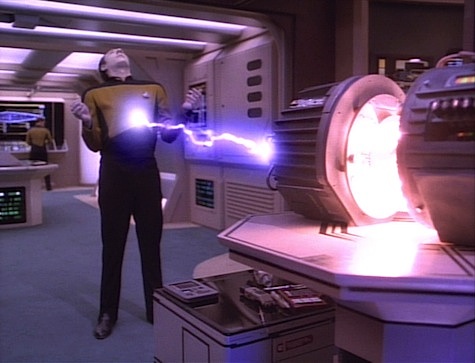
Thank You, Counselor Obvious: Troi, knowing full well that asking Worf if he wants to talk is pointless, simply walks into his quarters, snarks him off, and sits down on his sofa staring at him pointedly until he starts talking.
If I Only Had a Brain…: Data can stimulate hair growth (that explains the beard in “The Schizoid Man,” and is also a handy way of explaining the different wigs they’ve put on Brent Spiner), and he breathes (a handy way of explaining why Spiner breathes) and has a pulse. And now he can dream. Pretty danged impressive.
No Sex, Please, We’re Starfleet: Worf enjoys watching Ba’el bathe so much that she sees him hiding in the shrubbery. Obviously, he failed his stealth roll….
There is No Honor in Being Pummeled: Worf is able to navigate the thick, dense jungle at night with its aboreal needle snakes and whatnot, and later sneaks into the camp without anybody noticing, including the guards who wear Romulan military uniforms. Which makes it even more hilarious that he’s discovered by a nude bather….
I Believe I Said That: “Did the table do something wrong?”
“No.”
“I’m glad you weren’t that hard on Ensign Lopez.”
“He made a mistake. The duty roster was inaccurate.”
“Would you like to talk about what’s bothering you, or would you like to break some more furniture?”
Troi snarking Worf by way of getting him to open up.
Welcome Aboard: Siddig el Fadil takes time off from Deep Space Nine to wander the corridors of the Enterprise as Dr. Bashir. James Cromwell—having previously played Prime Minister Nayrok in “The Hunted,” and who will play Hanok in DS9’s “Starship Down” and Zefram Cochrane in Star Trek: First Contact (and a couple of Enterprise episodes)—plays Jaglom Shrek. Cristine Rose, Jennifer Gatti, and Richard Herd all make brief appearances as Klingons who will have much bigger roles in Part 2. And Brent Spiner, having played the elderly Noonian Soong in “Brothers,” now plays an image of his young self here. (He’ll play a middle-aged version of Soong in “Inheritance.”)
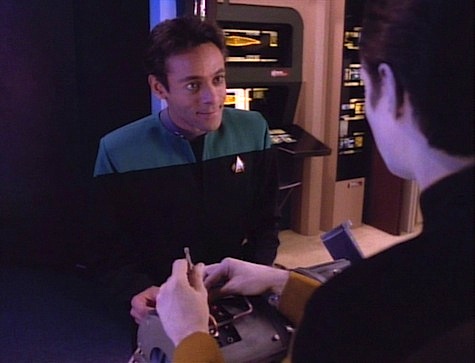
Trivial Matters: For Deep Space Nine’s pilot, Sir Patrick Stewart guest-starred and the Enterprise appeared both externally and internally. For this episode, DS9 returns the favor, as several scenes take place on DS9’s Promenade, replimat, and corridor sets and Siddig el Fadil guest stars. Based on stardates, the episode takes place between “Q-Less” and “Dax,” though the episode aired the same week as “The Passenger.”
The script originally called for Dax to be the crossover character, but Terry Farrell’s shooting schedule for “Move Along Home” precluded that, so they subbed in Bashir.
This is the first appearance of the Yridian species, which will continue to appear regularly on TNG and the other three spinoffs.
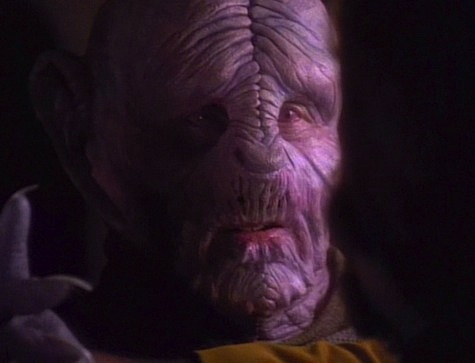
Worf will return to Deep Space 9 as an officer in the DS9 episode “The Way of the Warrior” when Michael Dorn joined the cast of the show.
This episode has two callbacks to second-season episodes: “Time Squared,” when Worf loves food that everyone else hates, and “The Emissary,” when K’Ehleyr (like Worf in this episode) smashes a table just before Troi comes in to say hi and be snarky.
This is the last true crossover between TNG and DS9 on screen, though the crews will be seen working together in the tie-in fiction quite a bit. Among the many examples: the comic book miniseries Divided We Fall, written by John J. Ordover & David Mack, and The Landmark Crossover, co-published by DC & Malibu, written by Michael Jan Friedman & Mike W. Barr; the novels Avatar Books 1-2 by S.D. Perry; and your humble rewatcher’s eBook novella Enterprises of Great Pitch and Moment (the last part of the Slings and Arrows miniseries).
Data’s dream program will next be seen in “Phantasms.” More details of Worf’s experiences with visions will be seen in “Rightful Heir.”
In Bashir’s final scene, when he walks away from Data down the corridor after wishing him “sweet dreams,” Siddig el Fadil is wearing sneakers instead of his uniform boots. And during the part of the final dream sequences, when Data is “flying,” if you look really quick, you can see makeup artist June Abston Haymore sitting in a corridor.
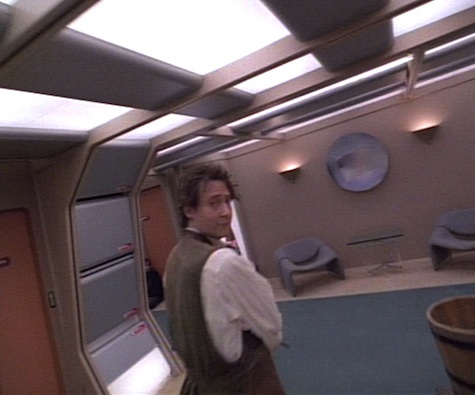
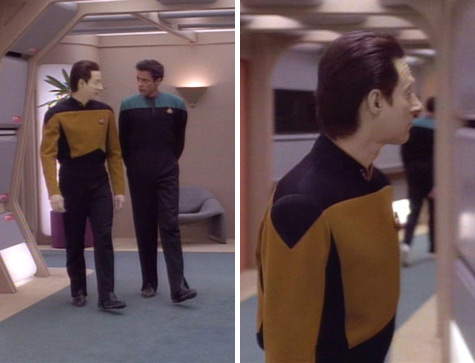
Make it So: “Your father is a part of you.” I’m inordinately fond of this two-parter, but I actually have always skipped this part in order to get to the much more interesting (to me, anyhow, but we’ll get to that on Tuesday) second half. So I had forgotten how good a spotlight this was for TNG’s two breakout characters, Worf and Data, as they deal with their unique father issues.
(It’s also amusing to see the wide-eyed first-season-of-DS9 Julian Bashir. There’s a character who grew up a lot over seven years…)
There are three great conversations here. The first is between Bashir and Data, where Data expresses surprise that Bashir asks about the more mundane aspects of Data’s artificiality—growing hair and such—rather than the parts of him that are better, faster, stronger. The second grows from that, and it’s Picard telling Data that he’s a culture of one—which is really such a great moment, and you can see the light bulb going off over Data’s head. Yes, he’s tried to become more human, but sometimes that’s less important than becoming more Data. He is more or less unique (Lore’s still floating around out there, after all, as we’ll be reminded at season’s end), and for all that he looks human and can do human things, he is also something other. Even his dreams are detailed and unique—I’ve never had a dream as coherent as what Data dreams in this episodes (and what we’ll see from the program in the future), which makes sense given the way Data functions.
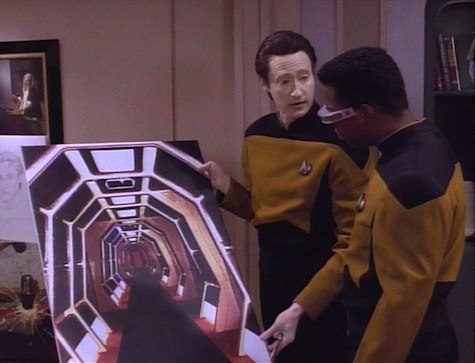
The third is between Worf and Data, as Data queries the only guy on the ship who gets spirituality about his vision. The talk is very enlightening regarding both characters, with Data as always trying to research everything, and Worf finally able to realize what he must do.
Even as Data pursues the vision of his father, Worf eventually realizes he has to do likewise for the “vision” provided by Shrek. Worf has had so much crap thrown at him that it’s understandable that he would want to avoid yet another bit of mishegoss to add to the very large pile, but ultimately, he has to follow Shrek’s lead and see where it goes.
I think I often skipped this episode because it felt too small, but sometimes small is good. The steps that Worf and Data take in this episode aren’t massive or earth shaking, but that doesn’t make them any less revelatory or any less important to them as people. And over five-and-a-half years, these two characters in particular have become people about whom we care enough that even the short journeys are worth taking.
Warp factor rating: 9
Keith R.A. DeCandido will be at Philcon 76 in Cherry Hill, New Jersey this weekend. Check out his schedule here. He’s moderating a panel on TNG at 25, alongside Glenn Hauman, Kim Kindya, and Allyn Gibson, on Saturday at noon. Come check it out!










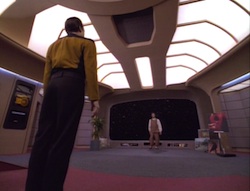
“he rips Ensign Lopez’s head off for a poorly prepared duty roster”
The problem with that statement, Keith, is that this being Worf, it’s too easy to take it literally. :-)
I always felt this two-parter was lopsided, as the Data plot (IIRC) gets wrapped up in part one, and the Worf part is all we get in part two. It’s like the Worf material was too much for one episode but not enough for two, so they combined it with the Data part to create the two-parter. I’d much rather have seen both stories continue into the second week.
— Michael A. Burstein
Good review.
You point out that this is the last true crossover between TNG and DS9, and while that is mostly true, Quark does make a small appearance in “Firstborn,” late in Season 7. It may be worth mentioning.
I’m surprised this episode got such a high rating. I know the rating is the least important part, yada, yada. To me, this one was just sort of ho hum, not terrible, but not too exciting either. It’s interesting to see how people’s opinions differ.
I have kind of the opposite reaction to the two parts, Keith. I love the Data dream plot and am less fond of the Worf stuff. I was a little disappointed that the dream story didn’t continue into part 2, though it certainly makes for a distinctive plot structure.
The climactic dream sequence with the “flight” out of the ship and into space was one of the most beautiful things ST ever achieved. The visuals and Jay Chattaway’s music were transcendent.
In the scene where Worf threatened Shrek on the Promenade, it’s always bothered me that Odo didn’t show up to deal with the commotion. I can understand that they couldn’t afford to hire two DS9 cast members, but it felt off. Maybe Odo was regenerating at the time, though.
I liked this episode (mostly the Data parts) as the Worf stuff seemed on a very slow burn.
Bashir guest starring was pretty entertaining, and you are right that his character did go through alot of change by the end of DS9. Which brings up a slightly off-topic question. Once the rewatch for Next Generation is finished will you be moving on to DS9 and Voyager?
So, the funny thing is, I had the opposite reaction. I really liked this one – ESPECIALLY Data’s dreams, development, discovering his ‘culture’, etc, and was not a huge fan of all the Klingon stuff.
Perhaps I’ll save my rant on that for the next one, but I’m just going to be Judgy McJudgypants and say it – Klingon culture is stupid. I just am not into these honor/shame obsessed oh woe is me the shame will extend to my children’s children’s children cultures.
I mean, seriously, because Mogh POSSIBLY got captured (something that was probably beyond his control), Alexander is possibly shamed? I can see why certain parts of it appeal to a huge part of the fandom and of course there are some positive aspects of it – and I definitely enjoy Worf as a character as well as some of the other Klingon focused episodes, but it’s stuff like that which make the culture, in general, really unappealing to me.
Also, Christopher – my husband actually said the same thing about Odo not showing up or, you know ARRESTING Worf for potentially killing somebody (and yeah, in what culture is it considered okay to interrogate people by holding them over a railing?), haha.
Evidently it is ok to hold an Englishman upside down out a window if you are an ex CIA hitman :)
I quit watching DS9 pretty early on, and Bashir was always the most annoying of those characters to me, so when I saw this was a DS9 crossover, I wasn’t thrilled, and when I saw Bashir was the sole crossover character, naturally I was like “Crap!” So the episode isn’t a high point for me.
The broken table in the exchange between Worf and Troi[s]made something go,“Ding!” in my memory, so I checked back through the recap archives and whaddya know! The scene calls back to a moment between Troi and K’Ehleyr in “The Emissary.”[/s]Here’s the scene from “The Emissary,” thanks to the recap archives. It’s mostly just proof that Klingons hate coffee tables:
I Believe I Said That: “You’re upset.”
“Your finely honed Betazoid sense tell you that?”
“Well, that, and the table.”
Troi and K’Ehleyr, following K’Ehleyr smashing a table in frustration.
Oh man, I should really read more than the summary before I get all silly. Still, I’m glad the quote was there.
Batman.
Really, I have always loved that final shot of Data’s dream. “Be the bird.” But yeah, I kinda speed thouh this one to get to the next. Not that I dislike this episode, but some of the revelations in the next always appealed to me.
I enjoy Julian’s reaction to Data and all his questions. I found it cute; Dr. Bashir is still doing the wide eyed first mission season 1 vibe . I never thought of Data having a pulse because I know he’s being played by a guy that breathes and has a pulse.
I also found the story at little uneven in fact that Data’s is all wrapped up in part 1 and Worf is all part 2. It is also strange that Odo doesn’t show up when a guy is being dangled off the prominade. All in all I enjoyed this episode.
In the dream sequences with Data and Soong, did they use someone else’s hands to touch Data’s face, and have someone else laying on the bed while they focused on a distant Soong? The hands don’t appear to be Spiner’s, it doesn’t look like Spiner from the back (to me, but Lord knows, I’ve been wrong before… on Tuesday, to be exact) when he’s facing the camera. I’m less sure about the bed scene.
This two parter is a wonderful intro into confronting some larger issues down the road. The two parts are wonderfully linked by the exchange between Worf and Data and these exchanges highlight the relationship Data and Worf share as friends as the show continues. Datas discovery in part one is the better discovery of the two but Worf’s discovery resonates the odd pairings that keep happening on Star Trek. Personally this episode touches me because it aired near to my own fathers birthday. This episode is about sons engaging their fathers in a meaningful way.
@8: Imagine if you’d quit watching TNG early on because of the spandex uniforms, the weak plots, and of course THE BOY.
Keith, this review seems to have been posted as a standalone article instead of part of your TNG series. I hope there is a way to move it and save all the comments.
Watching this now, I find it terribly amusing to watch the scenes with Worf galavanting around DS9, since that will become his home.
A very strong episode imho. I think part II doesn’t beat this one.
I do have a question: Was the DS9-crossover simply there to get Shrek (or rather, his information) and Bashir (or rather his gamma-quadrant-thingy) into the scenario?
I liked this Bashir. Whereas I ‘ve become to dislike him before the end of season one in DS9. Funny thing is I had no recollection whatsoever Bashir had a role in TNG….
I’m surprised you haven’t mentioned David Mack’s new book, The Persistence of Memory, in connection with the dream plot & Data :)
But good review on a really interesting episode!
@17: I figure the DS9 crossover was included to cross-promote the new show — and also to help amortize the cost of all those expensive new sets and miniatures by using them in a TNG episode that needed a space station.
Noticed your episode numbers are off for the last couple ones… from Ship in a Bottle (actually #12, you have it as #11, the same as Chain of Command, Part II, the last correct one) and onwards. Aquiel should be #13, Face of the Enemy should be #14, Tapestry should be #15, and Birthright, Part I should be #16.
I’m sorry that it’s an error that’s making me post for the first time! I love reading your comments on the episodes.
Lisamarie – you; me; same wavelength! Klingon culture is stupid. All that “today is a good day to die” and “death before dishonor” pretty much makes it impossible for me to take their culture seriously and to believe it lasted long enough to become space faring.
Good ep. Next one is better. And oh boy, do I have lots of comments for the next part and the literature follow-up on some of the characters.
I know what the Gamma Quadrant machine is — it’s a Plot Device, working as intended.
rrrrrrrmmmmmm @@@@@#23: Well, sure it is, but you can’t paint a McGuffin Industries logo on the side. That’s just not cricket. As it goes, it’s not a bad plot device. We need to come up with an excuse for the Doc to help Data look at it in the first place, but that’s about as much convotion as is really necessary.
To backup what crzydroid said @16, this thread is difficult to find. It’s not on the Series’ front page, and it doesn’t show up under the TNG rewatch episode list. I had to click on Keith’s name to find it.
The sneaker thing is just a goof right? Not an indication that Data is already dreaming or anything like that?
This episode is a little slow, but fine, but I think it serves a prime example of TNG drifting to the “Data, Worf, and sometimes Picard” show. I remember when it first aired going “ugh, another Klingon episode plus a Data episode”. Also, I could never get over the utter stupidity of Bashir, LaForge and Data activating an unknown alien device 7 feet from the warp core. The Enterprise is a big-ass ship. You don’t have one room, like a shuttlebay or a lab, to try it out? Nah, let’s flip the “on” switch right next to raw anti-matter. The must be some Starfleet Corp of Engineers safety regulation to cover that one. Things like that totally take me out of an episode…
@27: Yeah, Voyager had the same policy of repeatedly experimenting with unknown and possibly dangerous devices within a few meters of the warp core.
In my younger days, I dabbled in the occasional starship design (not for Trek, but for my original universe), and one feature I eventually decided to incorporate was an outboard observatory module suspended on a strut from the underside of the ship. Mainly it was to insulate the module from the vibrations, emissions, and thermal noise of the ship that might interfere with astronomical observations, but I figured it was also where dangerous experiments would be conducted, so that if something blew up or released a lethal toxin or unleashed some ancient cosmic horror from its slumber, the rest of the ship would be safe. In TNG’s defense, I may have gotten the idea from “Unnatural Selection,” wherein they had the good sense to conduct a dangerous experiment in a shuttlecraft away from the ship. But that was the only time ST ever showed such regard for quarantine procedures.
Braga is the science fiction universe equivalent to comic books’ Rob Liefeld.
He killed Trek.
@29: Braga’s importance to the franchise is overstated by his critics. Braga worked for Rick Berman, who was ultimately in charge of everything from TNG through ENT. Braga was a staff writer in TNG’s later seasons (where he did a lot of his best work, including this episode), then rose through the ranks on VGR, becoming its showrunner for seasons 5 & 6 and then co-showrunning ENT with Berman for its first three seasons. He also co-wrote the first two TNG movies and had absolutely no involvement with the last two.
And as a writer, Braga usually wrote as part of a team — with Ron Moore on TNG and the movies, with Joe Menosky and later Kenneth Biller on VGR, and with Berman on ENT. Only a few of his scripts were solo efforts. I’m always puzzled by the contradiction that the people most eager to denigrate Braga’s work on Trek are also the ones quickest to give him 100 percent of the credit and ignore his collaborators.
I don’t believe any of the producers or writers “killed” TNG. The 7th season of TNG had its highest viewership yet, and there is no reason to believe it would have stopped increasing were it not cancelled.
What killed TNG was the production company. They wanted to create Star Trek movies and knew that it would have been practically impossible to film a TV series at the same time feature films were being produced.
I truly think it was a mistake to cancel the series when they did. If it continued into 1994-1995, I think it would have become even more successful. Generally I feel that popular shows should continue unless they can’t make a profit anymore (as with “Melrose Place”) or a lot of the cast dies or otherwise cannot continue.
@31: The claim in post 29 was that Braga “killed Trek,” not TNG. Presumably he was referring to the end of the continuing run of Trek TV shows with Enterprise and original-timeline movies with Nemesis. But of course no one person can be blamed for that — certainly not Braga, who as I said had zero involvement with the last two TNG movies. Modern Trek had an amazingly long run on TV, for 18 straight years. It was inevitable that it would run out of steam eventually as audiences and the media landscape changed. And of course Trek wasn’t killed even so, since it’s already come back stronger than ever in theaters after only a few years’ absence.
It would be interesting to see the Trek television franchise revived, in today’s high-quality cable drama style.
(It could be argued that DS9 had that level of quality, and in my memory it does, but I’m curious what the scrutiny of a rewatch would do to that memory..).
I do think TNG had run its course as a TV show by season 7.
I think Bashir had more to do in this one episode of TNG than he had in the 9 or 10 episodes of DS9 that had aired up to this point. I really liked him here. Siddig’s chemistry with Brent Spiner was very good. It would have been nice to have seen more of it.
i’m just watching TNG for the 1st time and have been enjoying reading your reviews as i go!
watching this episode came at an interesting time because i’m also currently reading A.C. Crispin’s TNG #13 novel ‘The Eyes of the Beholders’, published well before this episode. the plot involves the Enterprise coming across an alien artifact that makes people (and Data!) dream. so Data dreaming is not without precedent.
looking forward to the rest of the reviews as i finish of TNG, hopefully i’ll catch up to you at some point on your DS9 reviews.
Another trivial matter: This is the first of two appearances of Deep Space 9 outside of the station’s “home” series. The second is Voyager‘s pilot “Caretaker”. Since Quark appears in that episode, this is the only Star Trek episode in which the station appears but none of the DS9 regular characters do (unless you count future regular Worf).
Kindly disregard the second half of my additional trivial matter. My brain was seemingly half-asleep as it had completely slipped my mind that Julian appeared in this episode, in spite of the frequent mentions, the photos and the fact that I’ve seen this episode at least six times.
I’m very suitably embarrassed. I may never darken Tor’s door again!
One more compliment to pile on this episode: Data’s art is great. Too often, TV shows have characters produce art that is laughably bad or otherwise improbable for the characters. Data’s pieces here are at the quality of a journeyman professional artist or accomplished amateur.
And in the one over-the-shoulder shot, they take the time to have an actual artist stand in for Brent Spiner, so you can see them actually laying down some paint on the canvas. You know the typical TV “character painting” shot, where an actor sits in front of a finished piece, dryly moving the paintbrush inside a little black area.
…but then this episode does that same thing later on. Ah, well, so they did it right *and* wrong.
Anyway, good TV art, “Birthright”!
I’ve always found this part of this two-parter to be the far more interesting of the two episodes. Data’s dream sequence is one of my favorite scenes in all of TNG and it’s a terrific next step in Data’s quest to be more human. I also love the appearance of Dr. Bashir and I’m glad Terry Farrell was unavailable as Dax wasn’t a very interesting character to me early on in DS9 (even though I had a serious crush on her, haha). Just as the first part was an awakening of sorts for Data, the second part was similar for Worf. The thing I disliked the least in part two was its predictability. It was a nice story, but I felt it was easy to see where it was going from the beginning. I did, however, like that second TNG appearance of Alan Scarfe, always a welcome guest star.
I felt admit to a Klingon bias…. :)
—Keith R.A. DeCandido
This is a decent two-parter, but just as others, I do wonder if it would have been better as two separate episodes. I find Data’s story-line to be more evocative, and for that reason, I like the first part more. The Worf story-line isn’t bad, but gets bogged down in pride and prejudice (couldn’t resist!), and doesn’t have quite as strong a payoff. Some of Data’s later development falls into similar tedious exposition, but his element in this episode plays out well. I do feel the DS9 tie-in is unnecessary (obviously they were taking any opportunity to give DS9 a boost) although Bashir’s interaction with Data provides some value. At the end of the day, the fact that Data’s part wraps up so quickly and the rather fruitless tie-in with DS9 detract a little, but it’s still a pretty good episode overall. It may be a little nerdy, but I love the idea of an Easter Egg implanted in Data – in fact, it seems logical that Soong would leave programming that would only be activated upon reaching a certain level of maturity. It’s especially fun to watch Data turn a little OCD on the elements of his dreams. Then the closing dream sequence plays so well as pure fantasy that it makes it worth the watch alone. I suspect both story-lines would have benefited from being run separately, and I’d speculate that the free publicity for DS9 and the cliffhanger are the only reasons they were combined. So, I have some issues with it, but I’d still put it at a warp factor eight overall. It’s a fun watch regardless – I’d call it a 9+ on first watch – really my main disappointment is that I believe Data’s element in this episode could have been written into a top-ten episode on its own, but gets shorted a little in what we got.
Count me among those who deeply dug Data’s dream sequence, along with the thoughtful conversation between him and Picard that set it up. The pacing of this plotline was so deliciously odd in comparison to almost any episode I can think of. Loved it.
I’ve read that Shrek’s name came from Yiddish, per Braga, yet even so I wonder if the makeup artists were thinking of Max Schreck given how the shape of his bat-eared head is reminiscent of Nosferatu.